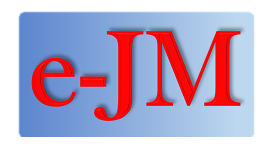Determinant Factors Of Business Resilience In Fishery Processing SMEs During The Covid 19 Pandemic
DOI:
https://doi.org/10.24912/jm.v26i3.1069Abstract
Fisheries processing entrepreneurs in Jakarta focus on developing strategic management by increasing innovation capabilities so as to improve organizational performance and have a significant competitive advantage so that they can survive the covid 19 pandemic. The population is 4 (four) DKI Jakarta municipality area with total sample of 100 fishery processing entrepreneurs. Samples were taken randomly and performed at some stage in February 2022. For records processing using convenience sampling. The study prove that competitive intensity has affect on organization performance, competitive intensity has affect on organization innovation, competitive intensity has affect on organization performance mediated by means of organization innovation, organizational slack has have an effect on on enterprise innovation, organizational slack has affect on business enterprise performance, organizational slack has affect on organisation overall performance mediated through organisation innovation, organization innovation has affect on organization performance although not sizeable.
References
Adam, J. K., Indradewa, R., Yanuar, T., & Syah, R. (2020). The Leadership Styles Impact, In Learning Organizations, And Organizational Innovation Towards Organizational Performance Over Manufacturing Companies, Indonesia. Journal of Multidisciplinary Academic 63 JoMA, 04(02), 63–69. https://kemalapublisher.com/index.php/JoMA/article/view/423.
Ahmed, N. & Afza, T. (2019). Capital Structure, Competitive Intensity And Firm Performance : Evidence From Pakistan. Journal of Advances in Management Research, 16(5), 796-813. doi:10.1108/JAMR-02-2019-0018.
Alawamleh, M., Bani Ismail, L., Aladwan, K., & Saleh, A. (2018). The Influence Of Open/Closed Innovation On Employees’ Performance. International Journal of Organizational Analysis, 26(1), 75–90. https://doi.org/10.1108/IJOA-08-2017-1207.
Aruchalam, S., Ramaswani, S. N., Hermann, P. & Walker, D. (2018). Innovation Pathway To Profitability: The Role Of Entrepreneurial Orientation And Marketing Capabilities. Journal of the Academy of Marketing Science, 46, 744–766. doi: 10.1007/s11747-017-0574-1.
Auh, S., & Menguc, B. (2005). Balancing Exploration And Exploitation: The Moderating Role Of Competitive Intensity. Journal of Business Research, 58(12), 1652–1661. https://doi.org/10.1016/j.jbusres.2004.11.007.
Brida, J. G., Driha, O., Ramón-Rodriguez, A.B., & Such-Devesa. M.J. (2016). The Inverted-U Relationship Between The Degree Of Internationalization And The Performance: The Case Of Spanish Hotel Chains. Tourism Management Perspectives, 17, 72–81. doi: 10.1016/j.tmp.2015.12.016.
Daniloska, N., & Mihajlovska, K. H. N. (2015). Rural Tourism And Sustainable Rural
Development. Economic Development, 3, 307-320.
https://repository.ukim.mk/handle/20.500.12188/2292.
Gabrys, B.J. (2018). Moderating Effect Of Organizational Slack On Organizational Renewal : The Dynamic Capabilities Approach. International Journal of Contemporary Management, 17(1), 27–43. doi:10.4467/24498939IJCM.18.002.8381.
Ganguly, A., Talukdar, A., & Chatterjee, D. (2019). Evaluating The Role Of Social Capital, Tacit Knowledge Sharing, Knowledge Quality And Reciprocity In Determining Innovation Capability Of An Organization. Journal of Knowledge Management, 23(6), 1105-1135. https://doi.org/10.1108/JKM-03-2018-0190.
Ghozali, I., & Latan, H. (2015). Partial Least Squares: Konsep, Teknik, Dan Aplikasi Menggunakan Program Smart PLS 3.0 (2nd ed.). Semarang: Universitas Diponegoro, Semarang.
Guha, M. (2016). Organizational Slack In Declining Firms And Surviving Firms. Journal of Strategy and Management, 9(1), 93–114. https://doi.org/10.1108/JSMA-11-2014-0092.
Hair, Joseph F., Hult, G. Tomas M., Ringle, Christian M. & Sarstedt, Marko. (2017). A primer on Partial Least Squares Structural Equation Modeling (PLS-SEM). SAGE Publications, Inc. USA.
Laksmana, I. & Yang, Y.W. (2015). Product Market Competition And Corporate Investment Decisions. Review of Accounting and Finance, 14(2), 1-34. doi: 10.1108/RAF-11-2013-0123.
Maravić, M. U., Križaj, D., & Lesjak, M. (2015). Innovation in Slovenian tourism organisations. Tourism and Hospitality Management, 21(1), 51–62. https://doi.org/10.20867/thm.21.1.4.
Marín-Idárraga, D. A., & Cuartas-Marín, J. C. (2019). Relationship Between Innovation And Performance: Impact Of Competitive Intensity And The Organizational Slack. RAE Revista de Administracao de Empresas, 59(2), 95–107. https://doi.org/10.1590/S0034-759020190203.
Masrizal (2012). Mixed Method Research. JKMA : Jurnal Kesehatan Masyarakat Andalas, 6(2), 53-56. https://doi.org/10.24893/jkma.v6i2.89.
Ngatno. (2015). Proactive Market Orientation, Radical Service Innovation, and Performance: Moderating Effects of Size and Competitive Intensity. International Journal of Management Sciences, 5(1), 68–84. http://www.rassweb.com.
Rampersad, G. (2020). Robot Will Take Your Job: Innovation For An Era Of Artificial Intelligence. Journal of Business Research, 116(January), 68–74. https://doi.org/10.1016/j.jbusres.2020.05.019.
Sekaran, U., & Bougie, R. (2016). Research Methods For Business (7th ed.). John Wiley & Sons, Ltd.
Smith, J. A., Flowers, P., & Larkin, M. (2009). Interpretative Phenomenological Analysis. SAGE Publications.
Suratman, D.J. (2021). Pemasaran Hasil Kelautan Dan Perikanan Di Masa Pandemi Covid 19 (Telaahan Pustaka). Direktorat Logistik : Direktorat Jenderal Penguatan Daya Saing Produk Kelautan dan Perikanan.
Suryawan, I. N. (2022). Maximizing Organization Performance: The Role of Travel Business in Jakarta? Jurnal Manajemen, 26(1), 17–34. https://doi.org/10.24912/jm.v26i1.832.
Turulja, L., & Bajgorić, N. (2018). Knowing Means Existing: Organizational Learning Dimensions and Knowledge Management Capability. Business Systems Research, 9(1), 1–18. https://doi.org/10.2478/bsrj-2018-0001.
Wagner, J. A., & Hollenbeck, J. R. (2014). Organizational Behavior: Securing Competitive Advantage. Routledge. doi: 10.4324/9780203385418.
Wilden, R., & Gudergan, S. (2017). Service-Dominant Orientation, Dynamic Capabilities And Firm Performance. Journal of Service Theory and Practice, 27(4), 808–832. https://doi.org/10.1108/JSTP-04-2016-0077.
Xing-Zhu, Y. & Qun, W. (2014). Exploratory Space–Time Analysis Of Inbound Tourism flows To China Cities. International Journal of Tourism Research, 16, 303–312. doi: 10.1002/jtr.1932.
Yoon, J., Kim, K.K., & Dedahanov, A. T. (2018). The Role Of International Entrepreneurial Orientation In Successful Internationalization From The Network Capability Perspective. Sustainability, 10, 1709. doi: 10.3390/su10061709.
Downloads
Published
How to Cite
Issue
Section
License
Copyright (c) 2022 Jurnal Manajemen

This work is licensed under a Creative Commons Attribution-NonCommercial-ShareAlike 4.0 International License.
This journal provides immediate open access to its content on the principle that making research freely available to the public supports a greater global exchange of knowledge.

This work is licensed under a Creative Commons Attribution-NonCommercial-ShareAlike 4.0 International License



















